[English] 日本語
 Yorodumi
Yorodumi- PDB-1ee4: CRYSTAL STRUCTURE OF YEAST KARYOPHERIN (IMPORTIN) ALPHA IN A COMP... -
+ Open data
Open data
- Basic information
Basic information
| Entry | Database: PDB / ID: 1ee4 | ||||||
|---|---|---|---|---|---|---|---|
| Title | CRYSTAL STRUCTURE OF YEAST KARYOPHERIN (IMPORTIN) ALPHA IN A COMPLEX WITH A C-MYC NLS PEPTIDE | ||||||
 Components Components |
| ||||||
 Keywords Keywords | TRANSPORT PROTEIN / ARM repeat | ||||||
| Function / homology |  Function and homology information Function and homology informationproteasome localization / positive regulation of metanephric cap mesenchymal cell proliferation / positive regulation of acinar cell proliferation / acinar cell proliferation / negative regulation of transcription initiation by RNA polymerase II / SCF ubiquitin ligase complex binding / NK T cell proliferation / Myc-Max complex / regulation of somatic stem cell population maintenance / regulation of cell cycle process ...proteasome localization / positive regulation of metanephric cap mesenchymal cell proliferation / positive regulation of acinar cell proliferation / acinar cell proliferation / negative regulation of transcription initiation by RNA polymerase II / SCF ubiquitin ligase complex binding / NK T cell proliferation / Myc-Max complex / regulation of somatic stem cell population maintenance / regulation of cell cycle process / Binding of TCF/LEF:CTNNB1 to target gene promoters / cellular response to interferon-alpha / RNA polymerase II transcription repressor complex / positive regulation of B cell apoptotic process / RUNX3 regulates WNT signaling / myotube differentiation / TFAP2 (AP-2) family regulates transcription of cell cycle factors / negative regulation of cell division / import into nucleus / negative regulation of monocyte differentiation / detection of mechanical stimulus involved in sensory perception of sound / response to growth factor / response to alkaloid / B cell apoptotic process / NLS-dependent protein nuclear import complex / transcription regulator activator activity / NLS-bearing protein import into nucleus / nuclear localization sequence binding / Transcription of E2F targets under negative control by DREAM complex / protein-DNA complex disassembly / negative regulation of stress-activated MAPK cascade / fibroblast apoptotic process / Regulation of NFE2L2 gene expression / protein targeting to membrane / positive regulation of mesenchymal cell proliferation / nuclear import signal receptor activity / regulation of telomere maintenance / skeletal system morphogenesis / Signaling by ALK / middle ear morphogenesis / branching involved in ureteric bud morphogenesis / negative regulation of gene expression via chromosomal CpG island methylation / rRNA metabolic process / pigmentation / E-box binding / positive regulation of telomere maintenance / skeletal muscle cell differentiation / positive regulation of intrinsic apoptotic signaling pathway by p53 class mediator / chromosome organization / positive regulation of transcription initiation by RNA polymerase II / negative regulation of fibroblast proliferation / core promoter sequence-specific DNA binding / Cyclin E associated events during G1/S transition / Cyclin A:Cdk2-associated events at S phase entry / ERK1 and ERK2 cascade / positive regulation of epithelial cell proliferation / transcription coregulator binding / SMAD2/SMAD3:SMAD4 heterotrimer regulates transcription / euchromatin / G1/S transition of mitotic cell cycle / MAPK6/MAPK4 signaling / protein processing / positive regulation of miRNA transcription / NOTCH1 Intracellular Domain Regulates Transcription / DNA-binding transcription repressor activity, RNA polymerase II-specific / cellular response to xenobiotic stimulus / Constitutive Signaling by NOTCH1 PEST Domain Mutants / Constitutive Signaling by NOTCH1 HD+PEST Domain Mutants / spindle / Wnt signaling pathway / Transcriptional regulation of granulopoiesis / positive regulation of fibroblast proliferation / intrinsic apoptotic signaling pathway in response to DNA damage / protein import into nucleus / disordered domain specific binding / cellular response to UV / nuclear envelope / MAPK cascade / regulation of gene expression / DNA-binding transcription activator activity, RNA polymerase II-specific / Interleukin-4 and Interleukin-13 signaling / cellular response to hypoxia / Estrogen-dependent gene expression / DNA-binding transcription factor binding / intracellular iron ion homeostasis / transcription by RNA polymerase II / DNA-binding transcription factor activity, RNA polymerase II-specific / protein dimerization activity / Ub-specific processing proteases / nuclear body / RNA polymerase II cis-regulatory region sequence-specific DNA binding / chromatin remodeling / response to xenobiotic stimulus / axon / positive regulation of cell population proliferation / DNA damage response / ubiquitin protein ligase binding / positive regulation of gene expression / regulation of transcription by RNA polymerase II / negative regulation of apoptotic process Similarity search - Function | ||||||
| Biological species |   Homo sapiens (human) Homo sapiens (human) | ||||||
| Method |  X-RAY DIFFRACTION / X-RAY DIFFRACTION /  SYNCHROTRON / Resolution: 2.1 Å SYNCHROTRON / Resolution: 2.1 Å | ||||||
 Authors Authors | Conti, E. | ||||||
 Citation Citation |  Journal: Structure Fold.Des. / Year: 2000 Journal: Structure Fold.Des. / Year: 2000Title: Crystallographic analysis of the specific yet versatile recognition of distinct nuclear localization signals by karyopherin alpha. Authors: Conti, E. / Kuriyan, J. | ||||||
| History |
|
- Structure visualization
Structure visualization
| Structure viewer | Molecule:  Molmil Molmil Jmol/JSmol Jmol/JSmol |
|---|
- Downloads & links
Downloads & links
- Download
Download
| PDBx/mmCIF format |  1ee4.cif.gz 1ee4.cif.gz | 179.5 KB | Display |  PDBx/mmCIF format PDBx/mmCIF format |
|---|---|---|---|---|
| PDB format |  pdb1ee4.ent.gz pdb1ee4.ent.gz | 141.1 KB | Display |  PDB format PDB format |
| PDBx/mmJSON format |  1ee4.json.gz 1ee4.json.gz | Tree view |  PDBx/mmJSON format PDBx/mmJSON format | |
| Others |  Other downloads Other downloads |
-Validation report
| Summary document |  1ee4_validation.pdf.gz 1ee4_validation.pdf.gz | 396.9 KB | Display |  wwPDB validaton report wwPDB validaton report |
|---|---|---|---|---|
| Full document |  1ee4_full_validation.pdf.gz 1ee4_full_validation.pdf.gz | 410.7 KB | Display | |
| Data in XML |  1ee4_validation.xml.gz 1ee4_validation.xml.gz | 18.3 KB | Display | |
| Data in CIF |  1ee4_validation.cif.gz 1ee4_validation.cif.gz | 29.8 KB | Display | |
| Arichive directory |  https://data.pdbj.org/pub/pdb/validation_reports/ee/1ee4 https://data.pdbj.org/pub/pdb/validation_reports/ee/1ee4 ftp://data.pdbj.org/pub/pdb/validation_reports/ee/1ee4 ftp://data.pdbj.org/pub/pdb/validation_reports/ee/1ee4 | HTTPS FTP |
-Related structure data
- Links
Links
- Assembly
Assembly
| Deposited unit | 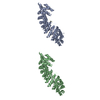
| ||||||||
|---|---|---|---|---|---|---|---|---|---|
| 1 | 
| ||||||||
| 2 | 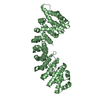
| ||||||||
| Unit cell |
|
- Components
Components
| #1: Protein | Mass: 46870.527 Da / Num. of mol.: 2 / Fragment: ARMADILLO DOMAIN / Mutation: Y397D Source method: isolated from a genetically manipulated source Source: (gene. exp.)  References: UniProt: Q02821 #2: Protein/peptide | Mass: 1000.215 Da / Num. of mol.: 4 Fragment: NLS (NUCLEAR LOCALIZATION SIGNAL) AT THE LARGER (FUNCTIONAL) BINDING SITE Source method: isolated from a genetically manipulated source Source: (gene. exp.)  Homo sapiens (human) / References: UniProt: P01106 Homo sapiens (human) / References: UniProt: P01106#3: Water | ChemComp-HOH / | |
|---|
-Experimental details
-Experiment
| Experiment | Method:  X-RAY DIFFRACTION / Number of used crystals: 1 X-RAY DIFFRACTION / Number of used crystals: 1 |
|---|
- Sample preparation
Sample preparation
| Crystal | Density Matthews: 2.2 Å3/Da / Density % sol: 44.03 % | |||||||||||||||||||||||||
|---|---|---|---|---|---|---|---|---|---|---|---|---|---|---|---|---|---|---|---|---|---|---|---|---|---|---|
| Crystal grow | Temperature: 298 K / Method: vapor diffusion, hanging drop / pH: 8.5 Details: pH 8.5, VAPOR DIFFUSION, HANGING DROP, temperature 298K | |||||||||||||||||||||||||
| Crystal | *PLUS Density % sol: 43 % | |||||||||||||||||||||||||
| Crystal grow | *PLUS Temperature: 4 ℃ | |||||||||||||||||||||||||
| Components of the solutions | *PLUS
|
-Data collection
| Diffraction | Mean temperature: 100 K |
|---|---|
| Diffraction source | Source:  SYNCHROTRON / Site: SYNCHROTRON / Site:  CHESS CHESS  / Beamline: A1 / Beamline: A1 |
| Detector | Detector: CCD |
| Radiation | Protocol: SINGLE WAVELENGTH / Monochromatic (M) / Laue (L): M / Scattering type: x-ray |
| Radiation wavelength | Relative weight: 1 |
| Reflection | Resolution: 2.1→30 Å / Num. all: 47949 / % possible obs: 96.9 % / Redundancy: 3.5 % / Rmerge(I) obs: 0.085 / Net I/σ(I): 15.8 |
| Reflection shell | Resolution: 2.1→30 Å |
| Reflection | *PLUS Lowest resolution: 30 Å / Num. obs: 47949 / Num. measured all: 152954 |
| Reflection shell | *PLUS % possible obs: 96.9 % / Rmerge(I) obs: 0.213 / Mean I/σ(I) obs: 6.6 |
- Processing
Processing
| Software |
| ||||||||||||
|---|---|---|---|---|---|---|---|---|---|---|---|---|---|
| Refinement | Resolution: 2.1→30 Å / σ(F): 0 / σ(I): 0 / Stereochemistry target values: Engh and Huber /
| ||||||||||||
| Refinement step | Cycle: LAST / Resolution: 2.1→30 Å
| ||||||||||||
| Refine LS restraints |
| ||||||||||||
| Software | *PLUS Name: CNS / Classification: refinement | ||||||||||||
| Refinement | *PLUS Highest resolution: 2.1 Å / Lowest resolution: 30 Å / σ(F): 0 / % reflection Rfree: 5 % / Rfactor obs: 0.246 | ||||||||||||
| Solvent computation | *PLUS | ||||||||||||
| Displacement parameters | *PLUS |
 Movie
Movie Controller
Controller




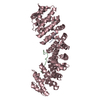
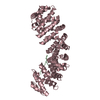
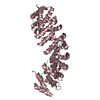

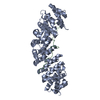
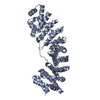


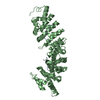
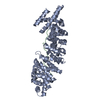
 PDBj
PDBj














